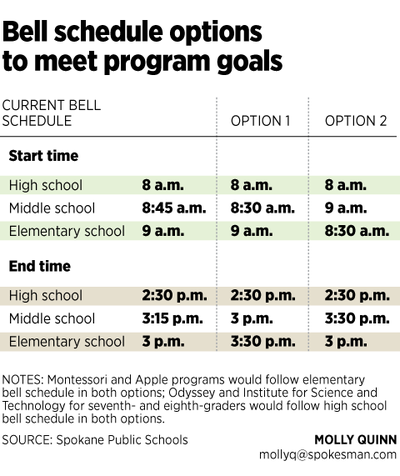Spokane school rescheduling options proposed

Spokane Public Schools officials now know how school schedules will need to change to accommodate adding 30 minutes to the school day for elementary students. There are two options under consideration, with a decision expected on March 11.
Both options mean a change for middle school students’ schedules, however.
The decision to extend the school day was made nearly a year ago to get Spokane caught up with districts across the nation.
Logistics for buses, food services, extracurricular activities and daily schedules must change to accommodate the new schedules.
The result: Either elementary students or middle school students will have to start earlier next fall.
“We are adding 30 minutes to the elementary school day, that’s a great position to be in,” said Deana Brower, a school board member.
For seventh- and eighth-graders, the two options have students arriving 15 minutes earlier or later than their current 8:45 a.m. start. Students would leave at either 3 or 3:30 p.m. depending on the start time.
The current elementary school schedule is 9 a.m. to 3 p.m. The two schedule options under consideration for those students are 9 a.m. to 3:30 p.m. or 8:30 a.m. to 3 p.m.
The district’s high school start times will remain at 8 a.m.
School board members said they were glad to see a later start time proposed for middle school students. Multiple studies have shown that adolescents who get more sleep do better academically.
Steven Gering, the school district’s chief academic officer, told the school board on Wednesday that “everyone would benefit from more sleep.”
But he noted that the district’s school start times are reasonable compared to others around the nation.
The average start time for high schools nationally is 7:59 a.m. Both University and Central Valley high schools start at 7:30 a.m. Mead School District’s middle and high schools start at 8:15 a.m.
Gering said changing the start time by a few minutes would offer minimal academic improvement, less than 1 percent. What would make a real academic difference is “extending the school year by three weeks,” he said.
Also coming next year: busing changes that district officials say will accommodate the new schedules and correct some inefficiencies.
To save time, buses will make fewer stops in neighborhoods, resulting in slightly longer walks for students. The typical walk next year will be three- to six-tenths of a mile, compared with one- to two-tenths now. The new busing schedule will allow students to arrive at school 20 minutes early, so they can eat breakfast. In addition, middle school students will be picked up right after school and busing to “option” schools, such as Montessori, could be made possible.
Jeff Bierman, board president, commended district officials during Wednesday’s board meeting. In addition to coming up with workable schedule options, he said, the administration has fixed more than one “long-standing” problem in transportation alone.
Once the board decides on a schedule, a letter explaining the changes will be sent to parents, followed by a newsletter and several verbal and electronic reminders.
Communication with families will be key, Superintendent Shelley Redinger said. District officials have already spoken with numerous parents who want to know about schedule changes since deciding to extend the elementary school day.
“I always say it’s like we are in people’s living rooms,” Redinger said. “It’s very personal to people.”